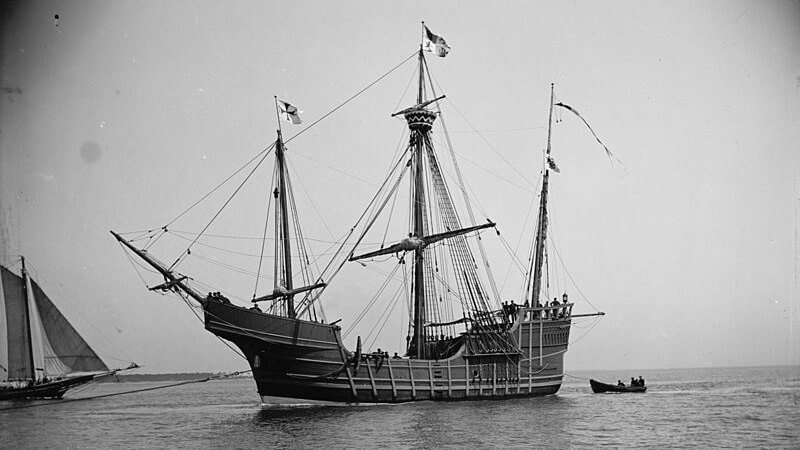Photo: Old photo of a replica of the Santa Maria (public domain)
As I am putting the last touches on an article about the La Belle shipwreck, “one of the most important marine archeological discovery of the century” (that would be the 20th century!), I could not help but be intrigued by all the hype this week around marine explorer Barry Clifford’s announcement that he had discovered the shipwreck of Christopher Columbus’ Santa Maria in relatively shallow waters off the coast of Haiti.
I have to say that I am on the side of skeptics. As mentioned by Laurence Bergreen, the author of “Columbus: The Four Voyages” and “Over the Edge of the World: Magellan’s Terrifying Circumnavigation of the Globe,” in his CNN commentary this week “Is shipwreck really the Santa Maria?“, there seems to be a lot of unanswered questions and need for convincing proofs.
I wonder in particular why nothing has been done since the discovery of the wreck in 2003 to protect the then-found cannon, a crucial artifact for the identification of the wreck, which has now disappeared.
Also, as mentioned by Kevin Crisman, director of the Center for Maritime Archaeology and Conservation at Texas A&M University, in an AP interview (CBS News article “Columbus’ long-lost ship, the Santa Maria, may have been found“) “there are reasons to be skeptical“. Many Spanish ships have sunk in the seawaters near Haiti and the Dominican Republic and it is going to be difficult to identify this wreck as being THE Santa Maria, especially because the ship sunk slowly and the crew had time to save all valuables before she was submerged. Artifacts such as cannons are invaluable to confirm the identity of the wreckage 500 years later.
Finally, it needs to be noted that it would take very particular environmental conditions for the shipwreck to be well preserved. In particular, its wooden frames would not survive for 500 years in those warm waters unless they would be enclosed in very dense material (like the silt which protected the La Belle in Texas waters). Cold waters can also help preservation, as seen in the case of the gorgeous Vasa (Vasa Museet, Stockholm) which sank in 1628 and was discovered in 1961, in a remarkable condition of preservation. She had sat in very cold waters all that time.
But what do YOU think? We’d love to hear from you (comment box below)!
More on the Story of the Santa Maria
The Santa Maria was of course one of the 3 vessels on the first voyage of Christopher Columbus (1492). On Christmas Eve that year, crew members were celebrating and drinking and, as the fleet was sailing on the northern coast of nowadays Haiti, the ship’s master turned over the tiller to a 14-year-old boy. The ship ran into a reef and sank slowly into 15 to 25 feet of water.
Additional Article
- Press conference of Barry Clifford at Explorer’s Club in New York City, Wednesday, May 14, 2014: “Ship believed to be Christopher Columbus’ Santa Maria has been looted: explorer“, showing a 2003 photo of a cannon at the wreckage site, and illustrations of 15th-century cannons.

